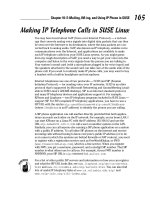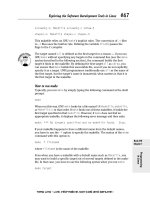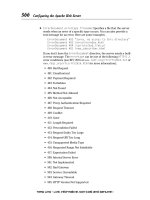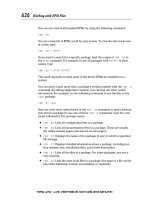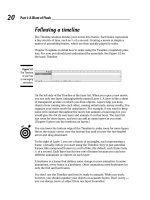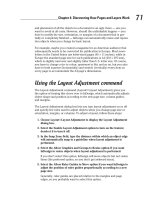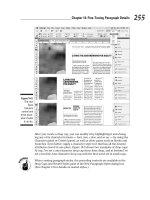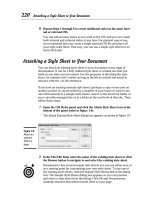Hacking FOR DUMmIES phần 7 ppsx
Bạn đang xem bản rút gọn của tài liệu. Xem và tải ngay bản đầy đủ của tài liệu tại đây (1.19 MB, 38 trang )
Countermeasures
The best defense against NFS hacking depends on whether you actually need
the service running.
ߜ If you don’t need NFS, disable it altogether.
ߜ If you need NFS, implement both of the following countermeasures:
• Filter NFS traffic at the firewall — typically, TCP port 111 if you
want to filter all RPC traffic.
• Make sure that your
/etc/exports and /etc/hosts.allow files
are configured properly to keep the world outside your network.
File Permission
In Linux, special file types allow programs to run with the file owner’s rights:
ߜ SetUID (for user IDs)
ߜ SetGID (for group IDs)
SetUID and SetGIF are required when a user runs a program that needs full
access to the system to perform its tasks. For example, when a user invokes
the passwd program to his or her password, the program is actually loaded
and run with root or any other user’s privileges. This is done so that the user
can run the program, and the program can update the password database
without root’s having to get involved in the process manually.
Hacks
By default, rogue programs that run with root privileges can be easily hidden.
A hacker may do this to hide such hacking files as rootkits on the system.
Countermeasures
You can test for these rogue programs by using both manual and automated
testing methods.
207
Chapter 12: Linux
18 55784x Ch12.qxd 3/29/04 4:19 PM Page 207
Manual testing
The following commands can identify SetUID and SetGID programs:
ߜ Programs that are configured for SetUID:
find / -perm -4000 –print
ߜ Programs that are configured for SetGID:
find / -perm -2000 –print
ߜ Files that are readable by anyone in the world:
find / -perm -2 -type f –print
ߜ Hidden files:
find / -name “.*”
You probably have hundreds of files in each of these categories, so don’t be
alarmed. When you discover files with these attributes set, you’ll need to
make sure that they are actually supposed to have those attributes by
researching in your documentation, on the Internet, or even by comparing
them to a known secure system or data backup.
Keep an eye on your systems to detect any new SetUID or SetGID files that
suddenly appear.
Automatic testing
You can use an automated file-modification auditing program to alert you
when these types of changes are made. This is what I recommend — it’s a lot
easier on an ongoing basis.
ߜ A change-detection application, such as Tripwire, can help you keep
track of what changed and when.
ߜ A file-monitoring program, such as COPS (
dan.drydog.com/cops), finds
files that have changed in status (such as a new SetUID or removed
SetGID).
Buffer Overflows
RPC and other vulnerable daemons are common methods for buffer-overflow
attacks. Buffer-overflow attacks are often how the hacker can get in to modify
system files, read database files, and more.
208
Part IV: Operating System Hacking
18 55784x Ch12.qxd 3/29/04 4:19 PM Page 208
Attacks
In a buffer-overflow attack, the hacker either manually sends strings of infor-
mation to the victim Linux machine or writes a script to do so. These strings
contain
ߜ Instructions to the processor to basically do nothing.
ߜ Malicious code to replace the attacked process.
For example,
exec (“/bin/sh”) creates a shell command prompt.
ߜ A pointer to the start of the malicious code in the memory buffer.
If an attacked application (such as FTP or RPC) is running as root (many pro-
grams do), this can give the hacker root permissions in his remote shell.
You can run security-testing tools against your systems to test for buffer
overflows, but I don’t recommend it, because it can crash your system!
Countermeasures
Three main countermeasures can help prevent buffer-overflow attacks:
ߜ Disable unneeded services.
ߜ Protect your Linux systems with either a firewall or host-based intrusion
prevention.
ߜ Enable another access control mechanism, such as TCP Wrappers, that
authenticates users with a password.
Don’t just enable access controls via an IP address or hostname. That
can easily be spoofed.
Always make sure that your systems have been updated with the latest
kernel and security patches.
Physical Security
Some Linux vulnerabilities involve the hacker’s actually being at the system
console.
209
Chapter 12: Linux
18 55784x Ch12.qxd 3/29/04 4:19 PM Page 209
Hacks
When a hacker is at the system console, anything goes, including rebooting
the system (even if no one is logged in) simply by pressing Ctrl+Alt+Del. After
the system is rebooted, the hacker can start it up in single-user mode, which
allows the hacker to zero out the root password or possibly even read the
entire
/etc/passwd or /etc/shadow file.
Countermeasures
Edit your /etc/inittab file and remark out (place a # sign in front of) the
line that reads
ca::ctrlaltdel:/sbin/shutdown -t3 -r now, as shown
in the last line of Figure 12-11.
If you believe that a hacker has recently gained access to your system either
physically or by exploiting a vulnerability such as a weak password or buffer
overflow, you can use the last program to view the last few logins into the
system to check for strange login IDs or login times. This program peruses
the
/var/log/wtmp file and displays the users who logged in last. You can
enter
last | head to view the first part of the file (the first ten lines) if you
want to see the most recent logins.
Figure 12-11:
/etc/ini
ttab
showing the
line that
allows a
Ctrl+Alt+Del
shutdown.
210
Part IV: Operating System Hacking
18 55784x Ch12.qxd 3/29/04 4:19 PM Page 210
General Security Tests
You can assess critical, and often-overlooked, security issues on your Linux
systems, such as the following:
ߜ Misconfigurations or unauthorized entries in the
/etc/passwd and
/etc/shadow files
ߜ Password policies
ߜ Users equivalent to root
ߜ Suspicious automated tasks configured in cron
ߜ Signature checks on system binary files
ߜ Checks for rootkits
ߜ Network configuration, including measures to prevent packet spoofing
and other DoS attacks
ߜ Permissions on system log files
You can do all these assessments manually — or, better yet, use an automated
tool to do it for you! Figure 12-12 shows the initiation of the Tiger security
auditing tool, and Figure 12-13 shows a portion of the audit results. Talk about
some great bang for no buck with this tool!
Figure 12-12:
Running
the Tiger
security
auditing
tool.
211
Chapter 12: Linux
18 55784x Ch12.qxd 3/29/04 4:19 PM Page 211
I like to run the Red Hat–focused Linux Security Auditing Tool (LSAT) in addi-
tion to Tiger. It’s similar to Tiger, but it also searches for Red Hat Linux-specific
security issues.
You can use to test for the SANS Top 20 (
www.sans.org/top20) Vulnerabilities
is VLAD the Scanner by the Bindview Razor security team. A portion of its
output is shown in Figure 12-14.
Patching Linux
Ongoing patching is perhaps the best thing you can do to enhance the secu-
rity of your Linux systems. Regardless of the Linux distribution you use,
using a tool to assist in your patching efforts makes your job a lot easier.
Figure 12-14:
Partial
output of the
VLAD the
Scanner
tool.
Figure 12-13:
Partial
output of the
Tiger tool.
212
Part IV: Operating System Hacking
18 55784x Ch12.qxd 3/29/04 4:19 PM Page 212
Distribution updates
The distribution process is different on every distribution of Linux. You can
use the following tools, based on your specific distribution.
Red Hat
You can use the following tools to update Red Hat Linux systems:
ߜ Red Hat Package Manager (RPM), which is the GUI-based application
that runs in the Red Hat GUI desktop. It manages those files with a .rpm
extension that Red Hat and other freeware and open-source developers
use to package their programs.
ߜ up2date, a command-line text-based tool that is included in Red Hat.
ߜ AutoRPM (
www.autorpm.org).
ߜ The open-source NRH-up2date (
www.nrh-up2date.org).
Debian
You can use the Debian Package System (dpkg) included with the operating
system to update Debian Linux systems.
Slackware
You can use the Slackware Package Tool (pkgtool) tool included with the
operating system to update Slackware Linux systems.
SuSE/Novell
SuSE (now owned by Novell) includes the YaST2 Package Manager.
Multiplatform update managers
Commercial tools add nice features over the standard package managers
(which I describe in this chapter), such as correlating patches with vulnera-
bilities and automatically deploying appropriate patches. Commercial tools
that can help with Linux patch management include BigFix Patch Manager
(
www.bigfix.com) and SysUpdate (www.securityprofiling.com).
213
Chapter 12: Linux
18 55784x Ch12.qxd 3/29/04 4:19 PM Page 213
214
Part IV: Operating System Hacking
18 55784x Ch12.qxd 3/29/04 4:19 PM Page 214
Chapter 13
Novell NetWare
In This Chapter
ᮣ Selecting NetWare hacking tools
ᮣ Port-scanning a NetWare server
ᮣ Gleaning NetWare information without logging in
ᮣ Exploiting common vulnerabilities when logged into NetWare
ᮣ Minimizing NetWare security risks
A
s much as some of Novell’s competitors like to say that NetWare is a
thing of the past, it’s still alive and kicking quite strongly. There are mil-
lions of NetWare users around the world. The organizations running NetWare
and other Novell products demand a solid directory-services infrastructure
and stable environment.
NetWare administrators — some of the best around — often overlook or deny
that NetWare is hackable. This chapter shows you how to test for the most crit-
ical NetWare exploits and outlines countermeasures to prevent the problems.
NetWare Vulnerabilities
Novell NetWare has a reputation as one of the most secure operating systems
available. This is one reason that you rarely hear of NetWare servers’ getting
hacked or having new vulnerabilities that crop up constantly. However, NetWare
has its security issues. Various NetWare vulnerabilities can be exploited —
from NDS (now called eDirectory) enumeration to remote password testing to
spoofing NetWare packets. Hackers can exploit many of NetWare’s vulnerabil-
ities without even logging into the server!
19 55784x Ch13.qxd 3/29/04 4:18 PM Page 215
NetWare servers are frequently the most vital servers within a network. They
often perform the following functions:
ߜ House critical files
ߜ Store replicas of the eDirectory database for hosting, replicating, and
managing such directory-service objects as user IDs, printers, organiza-
tional units, and application licenses
ߜ Host e-mail with Novell GroupWise
ߜ Host Web sites and Web applications with such programs as Apache and
Tomcat
ߜ Serve as firewalls with Novell BorderManager
Starting with NetWare 7, Novell will release a version of NetWare that’s Linux-
based. So, if you do a lot of work with NetWare, now’s the time to start beef-
ing up on your Linux skills!
Choosing Tools
The following are my favorite NetWare-specific tools — they can offer up
everything you need:
ߜ SuperScan (
www.foundstone.com) for port scanning
ߜ LANGuard Network Security Scanner (
www.gfi.com) for port scanning,
OS enumeration, and vulnerability testing
ߜ NCPQuery (
razor.bindview.com/tools/index.shtml) for server
and eDirectory enumeration
ߜ Remote (
packetstormsecurity.nl/Netware/penetration) for
Remote Console password cracking
Make sure that you have the latest version of Novell’s Client32 software from
download.novell.com on your test computer before running these tests.
Getting Started
Although NetWare doesn’t have many serious security vulnerabilities (rela-
tively speaking), a few stand out. The hacks in this chapter are against a
default installation of NetWare 5.1 from inside the firewall. However, these
216
Part IV: Operating System Hacking
19 55784x Ch13.qxd 3/29/04 4:19 PM Page 216
vulnerabilities and tests apply to most versions of NetWare 4.x and newer —
the ones running NDS and eDirectory. I also point out a few critical NetWare
3.x vulnerabilities.
Patches on your specific systems may have fixed some of these vulnerabili-
ties. If you don’t get the exact same results as shown in this chapter, you’re
probably safe!
If you have the latest Novell-supplied patches on your systems, your systems
are likely to be secure. However, the hacks in this chapter are significant, so
you should test for them to make sure that your server is safe.
Older versions of NetWare such as 4.2 and 5.0 are being phased out of sup-
port. You’ll no longer receive security updates for these versions.
Server access methods
You can access a NetWare server in the following four ways — each of which
affects how you can test:
ߜ Not-logged in: This is a connection where you simply perform port
scans or make NCP calls across the network without actually logging in.
ߜ Logged in: This connection requires you to log in with a valid bindery or
eDirectory user ID and password.
This is the basic method for accessing standard NetWare services.
ߜ Web access: This connection may be available if you’re running GroupWise
WebAccess e-mail services, various NetWare management tools, or other
basic Web-server applications.
ߜ Console access: This access method requires you to be either at the
server console or using a remote-connectivity product (such as NetWare’s
built-in rconsole or even a console that shipped with NetWare 3.x and
earlier systems).
When you finish scanning your NetWare systems for open ports and
general information gathering, you can test for common NetWare security
vulnerabilities.
Port scanning
Start testing your NetWare systems by performing an initial port scan to
check what hackers can see. You can perform these scans in two main ways:
217
Chapter 13: Novell NetWare
19 55784x Ch13.qxd 3/29/04 4:19 PM Page 217
ߜ If the server has a public IP address, scan from outside the firewall, if
possible.
ߜ If the server doesn’t have a public IP address, you can scan internally on
the network.
Hackers can be inside your network, too!
The SuperScan results in Figure 13-1 show several potentially vulnerable ports
open on this NetWare server, including FTP and the commonly exploited Echo
and Character Generator ports. In addition, the NetWare specific port 524 is
NCP (NetWare Core Protocol). NetWare uses this protocol for its internal com-
munications with such hosts as clients and other servers — similar to SMB in
Windows.
You may also find that GroupWise is running (TCP port 1677), as well as
potentially a Web server and other Web-based remote-access ports, such as
80, 443, 2200, 8008, and 8009.
You can also perform a scan with LANguard Network Security Scanner. Using
a commercial tool such as this can often provide more details about the sys-
tems you’re scanning than a basic port scanner. Figure 13-2 shows that it can
determine more information about the server, such as the NetWare version
and SNMP information. It also tells you what’s listening on the open ports
without your having to look them up.
Figure 13-1:
Using
SuperScan
to scan a
default
installation
of NetWare
5.1.
218
Part IV: Operating System Hacking
19 55784x Ch13.qxd 3/29/04 4:19 PM Page 218
NCPQuery
You can run NCPQuery with command line options to gather information
about your server and directory tree, including the server information shown
in Figure 13-3.
This is a lot of information for a hacker to see without being logged in!
Figure 13-3:
Server and
eDirectory
information
gleaned
with
NCPQuery.
Figure 13-2:
Gathering
details with
LANguard
Network
Security
Scanner.
219
Chapter 13: Novell NetWare
19 55784x Ch13.qxd 3/29/04 4:19 PM Page 219
Countermeasures
The following countermeasures can prevent the malicious enumeration of
your NetWare systems:
ߜ Installing the latest patches can eliminate many NetWare server
vulnerabilities.
If your NetWare version has been or will be phased out by Novell —
meaning that it no longer provides security patches — you should seri-
ously consider upgrading to the latest version.
ߜ Port scanning can be performed with two steps:
1. Unload any unneeded services, which in turn closes any associ-
ated ports.
2. Place the server behind a firewall to help block outsider attacks.
ߜ Blocking NCP port 524 at the firewall is the only way to disable an
NCPQuery type of attack from outside.
This may not help much for insider attacks. Internal network communi-
cations require the NCP port 524 to be available.
ߜ Use strong passwords for all user IDs in case a hacker discovers an ID
and attempts to log in.
Authentication
If a hacker can gather information such as the server, eDirectory, and user ID
information, he may be able to exploit a known vulnerability or even try to
log in by using the user IDs that he discovered. When he’s in, all bets are off,
and anything goes. He could
ߜ Log into your network as a regular user.
ߜ Log into your network as admin.
ߜ Obtain physical access to the server console.
It’s wise to assume that a hacker could log in as a user or administrator on
your NetWare system and test for the worst-case scenario.
220
Part IV: Operating System Hacking
19 55784x Ch13.qxd 3/29/04 4:19 PM Page 220
Rconsole
One of the most serious NetWare security vulnerabilities is the NetWare
Remote Console program (referred to as rconsole). Rconsole is an SPX
protocol–based remote-control program similar to telnet and Windows
Terminal Services. It gives users full access to the NetWare console if they
know the password. rconsole consists of the following:
ߜ The
remote.nlm and rspx.nlm files on the server
ߜ The
rconsole.exe client program in the sys:\public directory
ߜ For rconsole to work, you must load the rspx NLM with one of these
methods:
• Enter
load rspx at the console.
• Place it in your
autoexec.ncf or ldremote.ncf file just below
your load remote line.
Attacks
Rconsole is vulnerable because its passwords can be easily obtained. The
passwords are stored in either clear text or an easily crackable hash format
on the server in the
sys:\system\autoexec.ncf file or sys:\system\
ldremote.ncf
files.
If you encrypt your rconsole passwords, cracking them is simple. The follow-
ing steps demonstrate how vulnerable the rconsole password really is:
1. Enter
load remote to load the remote NetWare Loadable Module
(NLM) on the server.
2. Enter the password you want to use when prompted.
3. Enter
remote encrypt and enter your rconsole password again when
prompted.
The server generates the encrypted password and displays the entire
command you need to run on the screen, including the hashed pass-
word. It looks similar to the response in Figure 13-4.
The server may also enter the command into the
ldremote.ncf file,
but it sometimes fails. For simplicity, just enter the
load remote -E
password
command manually into your autoexec.ncf file. Don’t write
this password down somewhere that’s easily accessible to others.
221
Chapter 13: Novell NetWare
19 55784x Ch13.qxd 3/29/04 4:19 PM Page 221
Now it’s time to try cracking the encrypted rconsole password. For this, I use
the remote cracking program — not to be confused with the remote NLM
that’s part of rconsole.
Simply run the
remote.exe cracking program against the rconsole password
hash that’s displayed on the screen (or stored in the server’s
autoexe.ncf
or ldremote.ncf file). Enter a line like the following at a command prompt:
remote password_hash
The result is the rconsole password.
You can try the preceding steps against my password. Figure 13-4 shows the
hash:
287502221D2EBB4BCDD44BDC68
Anyone using the following three items can even capture the encrypted rcon-
sole password traveling across the wire and decrypt it:
ߜ Network analyzer
ߜ Rcon program (
packetstormsecurity.nl/Netware/penetration/
rcon.zip
)
ߜ The steps outlined in the
rconfaq.txt file at packetstormsecurity.
nl/Netware/audit/rconfaq.zip
Figure 13-4:
Encrypting
your
rconsole
password.
222
Part IV: Operating System Hacking
19 55784x Ch13.qxd 3/29/04 4:19 PM Page 222
The remote NLM stores its password in server memory. Anyone with console
access can go into the NetWare debugger by pressing Shift+Alt+Shift+Esc
(yes, you use both Shift keys) on the server keyboard and view it in clear
text. The process is explained at
packetstormsecurity.nl/Netware/
audit/rconfaq.zip
.
Countermeasures
The following can prevent attacks against NetWare servers running rconsole:
ߜ Don’t use rconsole — at least, don’t use it on critical NetWare servers.
(Does anyone have a server that isn’t critical?)
ߜ If you must use rconsole, secure it with one of the following steps for
your version of NetWare:
• In NetWare 4.x or earlier, lock your server by using the monitor
NLM.
• With NetWare 5 and newer, load the scrsaver NLM. It displays the
fancy text-based NetWare snake and requires a valid NetWare
account to unlock.
ߜ Consider using one of these remote NetWare management programs
instead of rconsole:
• Rconj is a Java-based version of rconsole that’s able to work over
using TCP. It comes with NetWare 5.x and later but has limited
functionality.
Be sure to patch Rconj if you run it on NetWare 6. Rconj has a known
authentication vulnerability when running on NetWare 6 that allows a
hacker to gain access without a password.
• AdRem Software (
www.adremsoft.com) offers a couple of great
rconsole replacements that I highly recommend you check out.
• AdRem Free Remote Console runs on NetWare 4.x SP9 and later
servers.
As the name implies, it’s free!
AdRem Free Remote Console doesn’t encrypt remote-console com-
munications, but it does require a valid NetWare login with a user
ID that has console operator privilege (such as admin or equiva-
lent). This adds a level of security that plain old rconsole just can’t
offer.
• AdRem sfConsole is a commercial product with a ton of features,
including encrypted communications and a Web-based interface.
223
Chapter 13: Novell NetWare
19 55784x Ch13.qxd 3/29/04 4:19 PM Page 223
Server-console access
Physical access to the server console is a hacker’s pot of gold. After hackers
obtain this access, they can do practically anything they want to with the
server. This includes accessing the NetWare debugger to retrieve passwords
and potentially other confidential information stored in memory — not to
mention crash the server and more.
The following countermeasures help ensure that NetWare console access is
minimized to only those who are authorized:
ߜ Physical security is a must. Chapter 6 explains how to secure server
rooms.
ߜ Lock the server screen. You can keep the server console secure by either
selecting the Lock Server Console option in the monitor NLM or loading
the scrsaver NLM.
Intruder detection
Intruder detection is one of the most critical security features built into
NetWare. It locks a user account for a specific period of time after a certain
number of failed login attempts.
Make sure that intruder detection is enabled on your system. It’s disabled by
default.
Testing
Default settings for intruder detection — after it’s enabled — in NetWare 5.1
are shown in Figure 13-5. Chapter 7 details intruder detection.
Try logging in with invalid passwords for several test users — preferably,
users from different organizational units (OUs) within eDirectory — to see
whether intruder detection is working. Make sure that you type bad pass-
words; blank ones don’t seem to work well for this test. Here’s how you know
whether intruder detection is working:
ߜ If intruder detection is on, you should get a response similar to
Figure 13-6.
ߜ If intruder detection is off, you get prompted over and over again for a
password.
This is how hackers test whether intrusion detection is enabled on your
NetWare server.
224
Part IV: Operating System Hacking
19 55784x Ch13.qxd 3/29/04 4:19 PM Page 224
Countermeasures
You can implement the following countermeasures to ensure that unautho-
rized logins are minimized and intruder detection is not abused:
ߜ Enable intruder detection as high in the directory tree as possible —
preferably, at the uppermost organization level.
This is one of the best hacking countermeasures you can implement in a
NetWare environment.
ߜ Look for evidence that the console NLM was unloaded by searching for
entries in the
sys:\etc\console.log file.
ߜ Consider logging all events to a remote syslog server to help prevent a
hacker from tampering with evidence.
Rogue NLMs
If a hacker gains console access to your server, a legitimate yet potentially
dangerous NLM can be loaded, which can do bad things to the system.
Figure 13-6:
A Novell
Client32
message.
Figure 13-5:
Intruder-
detection
settings in
NetWare
5.1.
225
Chapter 13: Novell NetWare
19 55784x Ch13.qxd 3/29/04 4:19 PM Page 225
Testing
The following tests look for rogue NLMs running on your server.
Modules command
You can use the modules command at the server console prompt to view
loaded modules. As shown in Figure 13-7, you simply enter the command
modules at the server-console screen, and it displays a listing of NLMs that
are loaded — from first to last in order of loading.
Look for these NLMs in the modules output. If neither you nor another admin-
istrator has loaded the following NLMs, you have a problem:
ߜ Password reset tools:
• setpwd
This third-party NLM can reset any user’s password on the server —
including admin! It’s located at
ftp.cerias.purdue.edu/pub/
tools/novell/setpwd.zip
.
• setspwd
This program resets the supervisor/admin password for NetWare
3.x and 4.x.
• setspass
This program resets the supervisor password for NetWare 3.x
systems.
Figure 13-7:
Viewing
loaded
applications
on a
NetWare
server.
226
Part IV: Operating System Hacking
19 55784x Ch13.qxd 3/29/04 4:19 PM Page 226
ߜ dsrepair: This built-in NLM can corrupt or destroy eDirectory. It’s actu-
ally intended to repair and maintain the eDirectory database.
ߜ netbasic: This built-in NLM can copy eDirectory files from the hidden
sys:\_netware directory. It accesses a DOS-like prompt on the server.
Check whether the nwconfig NLM is loaded. This built-in NLM is often used
for day-to-day server maintenance, such as installing patches and editing
system files. However, a hacker can load it and back up or restore the
eDirectory database so that its files can be copied for malicious purposes.
You can look to see if the NLM is loaded by either
ߜ Looking at the modules output
ߜ Pressing Ctrl+Esc to view all loaded applications
ߜ Pressing Alt+Esc to toggle through all loaded applications
Many NLMs can load on a NetWare server — especially in the more recent
versions. If you have a question about what an NLM does or want to see
whether it’s valid, you can search on the filename at
www.google.com or at
support.novell.com to get more information.
A port scan of the server from another computer can find rogue applications
as well.
Tcpcon
The tcpcon NLM shows ports that are listening and connected. Follow these
steps to use it:
1. Enter
load tcpcon at the server prompt.
2. Select Protocol Information from the main menu.
3. Select TCP and then TCP Connections to view the TCP ports that are
open.
4. Select UDP and then UDP Listeners to view the UDP ports that are
open.
Figure 13-8 shows the TCP ports that are open and listening on this
server, including chargen, FTP, and NCP.
If something doesn’t look right, it may not be, so investigate the port number
further. My favorite port number reference is at
www.iana.org/assignments/
port-numbers
, but a simple Google search usually is productive.
227
Chapter 13: Novell NetWare
19 55784x Ch13.qxd 3/29/04 4:19 PM Page 227
Admin utilities
If hackers can successfully log in to a NetWare server or eDirectory, they can
use, in malicious ways, some of the great — and free — NetWare admin utili-
ties from JRB Software (
www.jrbsoftware.com). For example, hackers can
ߜ Run the downsrvr program to reboot a NetWare server — most likely at
the worst possible time.
ߜ Use the serv_cmd program to disable logins, remotely load NLMs, and
add bindery contexts to the system.
Countermeasures
The following countermeasures can minimize the chances that malicious
NLMs will be running on your servers.
Documentation
The best way to keep track of loaded NLMs is to document, document, and
document your server. It’s critical to know what’s supposed to be loaded on
your server at all times.
ߜ For each loaded NLM, you need to know its name, version, and date.
Keeping up-to-date records can get tedious, especially with a large
number of servers. Consider purchasing a commercial product —
NetServerMon or AdRem Server Manager — to help you manage this
task.
Figure 13-8:
Using
tcpcon to
show open
TCP ports
on a
NetWare
server.
228
Part IV: Operating System Hacking
19 55784x Ch13.qxd 3/29/04 4:19 PM Page 228
ߜ Save and print recent versions of your startup.ncf and autoexec.ncf
files.
ߜ Document — at least, at a high level — your eDirectory structure. You
can either
• Take a screen capture of eDirectory as it looks in NetWare
Administrator or ConsoleOne.
• Run
cx /t /a /r, and save the output of the program to a text file
by entering the following at a command prompt:
cx /t /a /r > filename.txt
Update your documentation after any system changes are made or any new
patches are applied.
Unauthorized logins
To prevent rogue NLMs or remote applications from being loaded or run from
a workstation, apply these security measures to your NetWare systems:
ߜ Make strong passwords on every NetWare account. I outline minimum
password requirements in Chapter 7.
ߜ Secure the server console.
ߜ Enable intruder detection.
ߜ Neutralize dangerous NLMs, such as netbasic. You can either rename
them or remove them.
If you remove dangerous NLMs, make a backup of the files first. You may
need them in the future.
Clear-text packets
Most internal LAN traffic — regardless of the operating system in use — trav-
els across the wire in clear text. The clear text can be captured and used
against you.
Packet capture
Clear-text packets can be captured with either
ߜ A network analyzer
ߜ Components of the Pandora NetWare hacking suite (
www.nmrc.org/
project/pandora
)
229
Chapter 13: Novell NetWare
19 55784x Ch13.qxd 3/29/04 4:19 PM Page 229
Pandora can spoof NCP packets, which can give them admin equiva-
lency on the network after the hacker logs in via a standard user
account that he previously compromised. A hacker could log in as a
normal user with a weak or blank password and then use Pandora to
manipulate NetWare traffic and get admin rights on the network.
Countermeasures
You can easily set up NCP packet signing within a NetWare environment. This
encrypts and provides proof that a packet actually originated from the send-
ing host. NCP packet signing has four levels, but the level for the utmost
security is level 3, which requires packet signatures.
This can slow network traffic and place a larger processing burden on your
server. Level-3 packet signing can decrease network performance on busy
NetWare servers — sometimes, by more than 50 percent.
The following steps explain how to enable level-3 packet signing:
ߜ Enable level-3 packet signing on the server and at the top of the
autoexec.ncf file with the following command:
set ncp packet signature option=3
ߜ Enable level-3 packet signing on NetWare clients with these steps:
1. Right-click your red Novell icon in your Windows system tray.
2. Select Novell Client Properties and Advanced Settings.
3. Set the Signature Level to 3 (Required).
In NetWare 3.x and earlier, passwords are sent in clear text across the net-
work. For these versions, you can enter the following command on your
server and in the
autoexec.ncf file to help prevent passwords from being
captured with a network analyzer:
set allow unencrypted passwords=off
General Best Practices for Minimizing
NetWare Security Risks
Although you can’t completely defend NetWare servers against attacks, you
can come close, which is more than you can say for other leading operating
systems. These NetWare hacking countermeasures can help improve security
on your NetWare server above and beyond what I’ve already recommended.
230
Part IV: Operating System Hacking
19 55784x Ch13.qxd 3/29/04 4:19 PM Page 230
Rename admin
Rename the admin account. Figure 13-9 shows how this can be done in the
Novell ConsoleOne utility.
Be careful. Other applications, such as the server backup software, may
depend on this ID.
If you rename admin, be sure to edit any backup jobs or startup scripts that
depend on the admin account. It’s actually best to not use the admin account
for these purposes anyway, so this may be a good time to make a change by
creating an admin equivalent for each application that’s dependent on an
admin ID. This can help make your system more secure by reducing the
number of places that the admin account is exposed and vulnerable to crack-
ing on the network.
Disable eDirectory browsing
A good way to ward off attacks is to disable Public’s right to browse the
directory tree in either NetWare Administrator for NetWare 4.x or Novell
ConsoleOne for NetWare 5.x and later. This right is enabled by default to
enable users to browse the eDirectory tree easily.
Figure 13-9:
Renaming
the
NetWare
admin
account
with
ConsoleOne.
231
Chapter 13: Novell NetWare
19 55784x Ch13.qxd 3/29/04 4:19 PM Page 231
